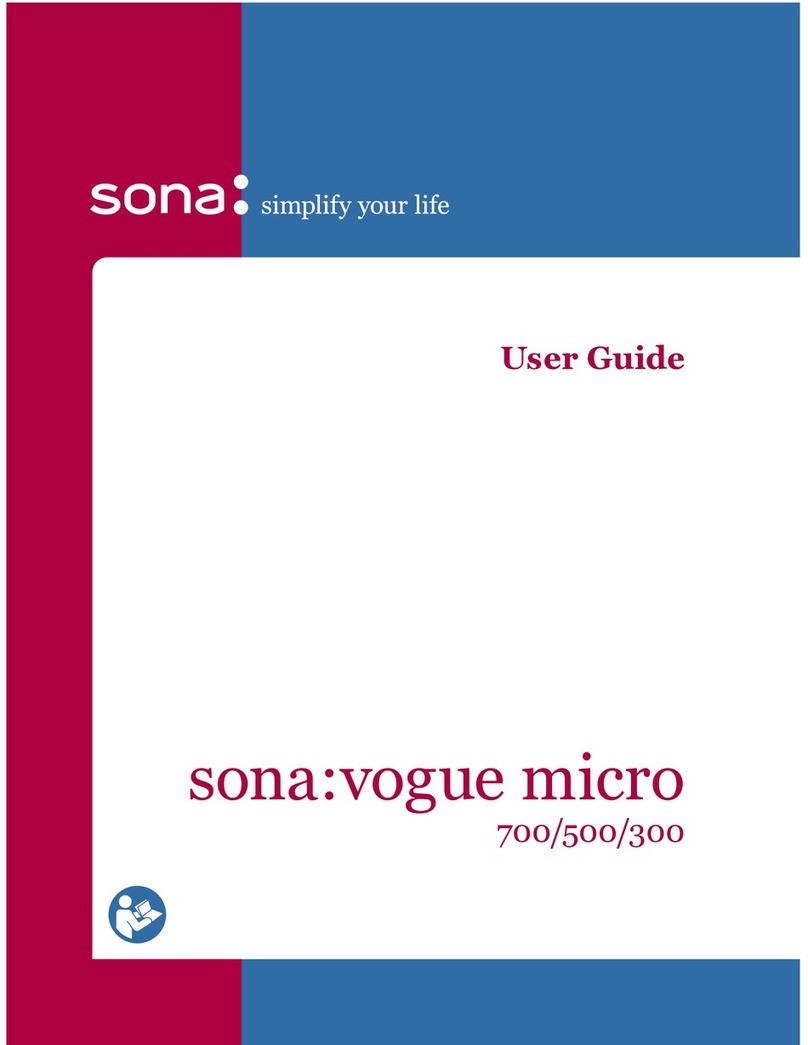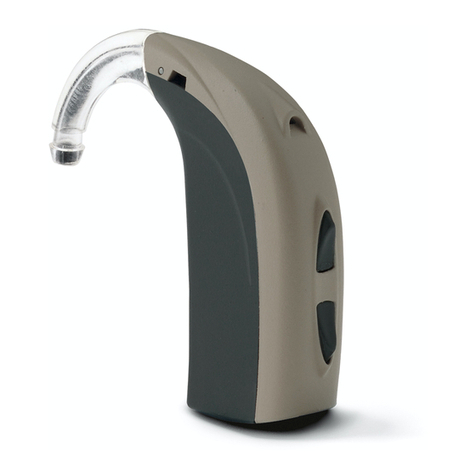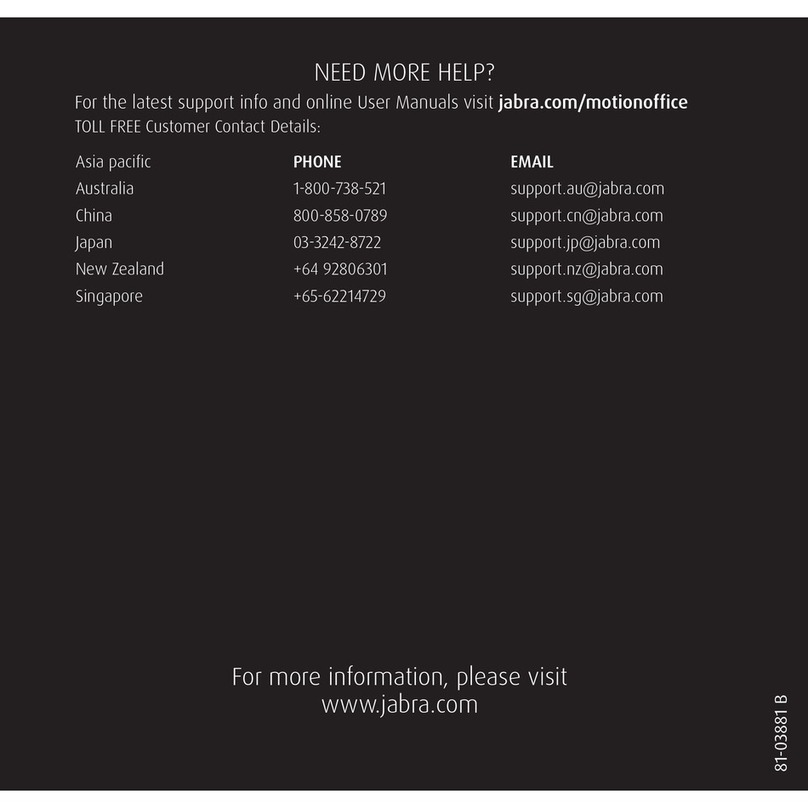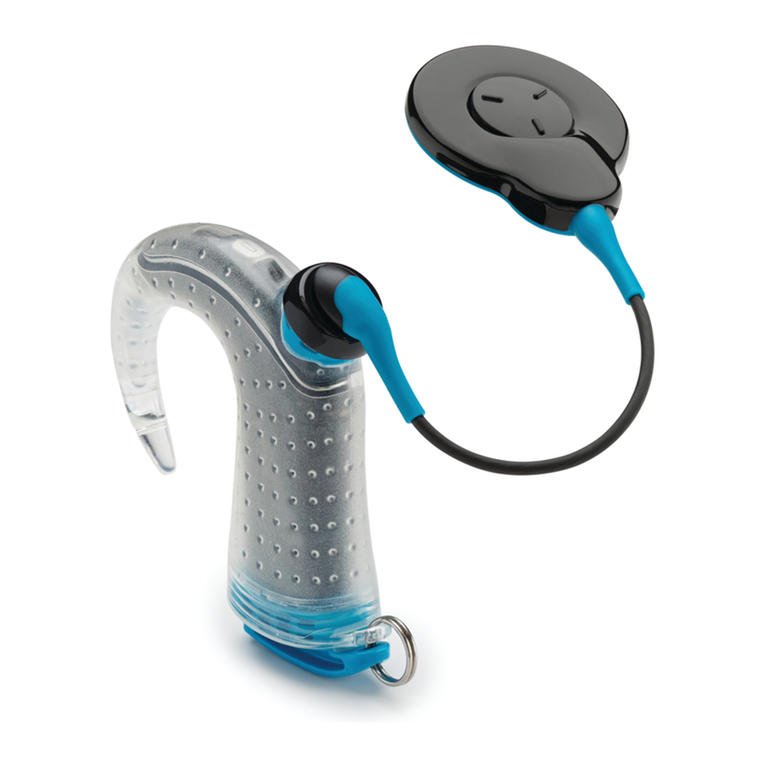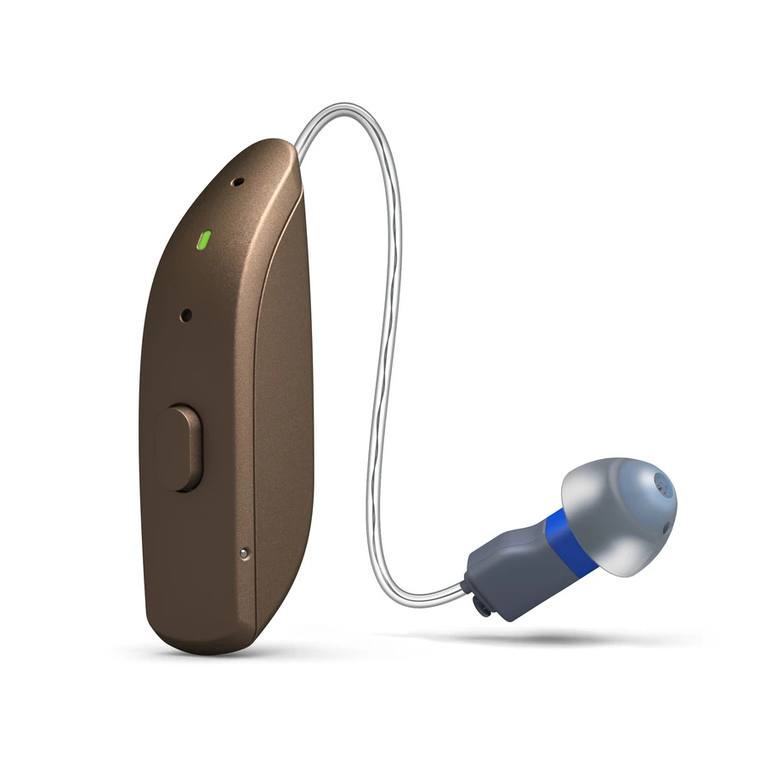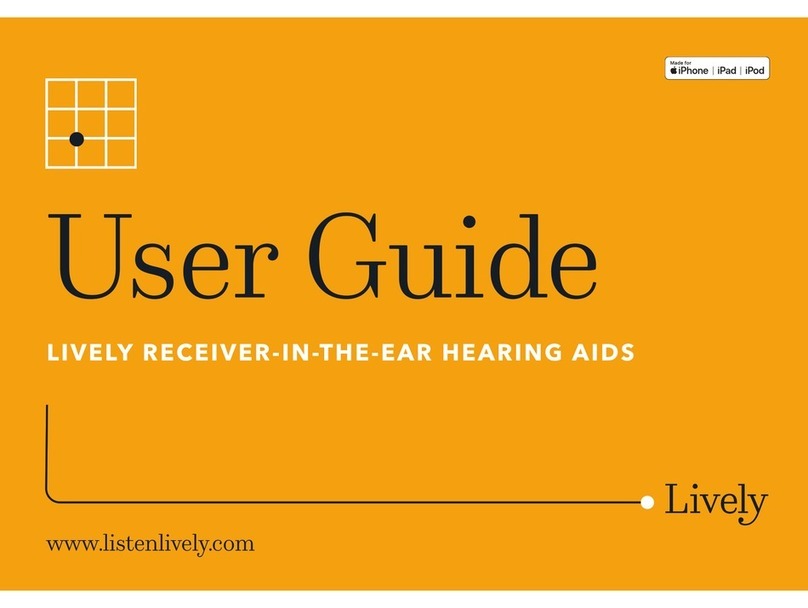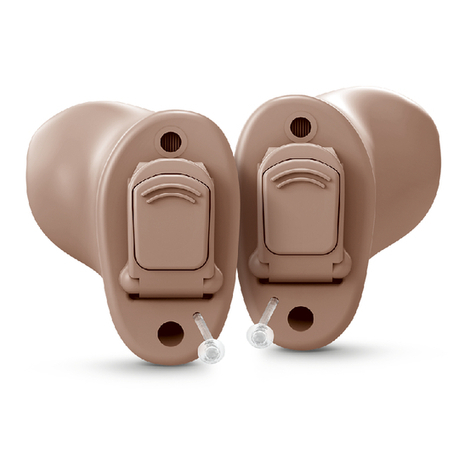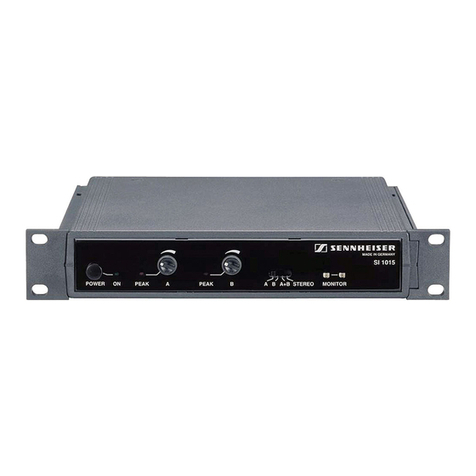Sona vogue ric 700 User manual

1
sona:vogue ric
700/500/300
User Guide

2 3
Welcome
sona:vogue ric is a fully automatic hearing aid
that combines high sound quality, best understanding
of speech, and optimal listening comfort. We are
convinced that the outstanding performance of
your sona:vogue ric will provide valuable benefits
in your daily life.
Please read this user guide thoroughly to benefit
from all the possibilities your new sona:vogue ric
has to offer. sona:vogue ric is a quality product
developed by the Swiss company Sona Hearing.
With proper use and care, you will be able to enjoy
your sona:vogue ric for many years to come.
If you have any questions, please consult your hearing
care professional. For further information,
visit
the Sona Hearing website at www.sonahearing.com
sona: simplify your life

5
Content
1. Important information 6
2. Product description 10
3. Step-by-step instructions 11
4. Care and maintenance 17
5. Troubleshooting 18
6. Service and warranty 20
7. Compliance information 21
8. Information and explanation
of symbols 22
9. FDA Regulations 24

6 7
1. Important information
Please read this information carefully before
using the hearing aid.
A hearing aid will not restore normal hearing and will
not prevent or improve a hearing impairment
resulting from organic conditions. Only regular use
of your hearing aid will help you to fully benefit from
it. The use of a hearing aid is only a part of hearing
rehabilitation and may need to be supplemented by
auditory training and instruction in lipreading.
Hazard warnings
Use only hearing aids that have been specially
programmed for you by a hearing care
professional. Other hearing aids may be
ineffective and may, in certain cases, even
damage your hearing.
Changes or modifications to the hearing aid
that were not explicitly approved by the manu-
facturer are not permitted. Such changes may
damage your ear or the hearing aid.
Hearing aid batteries are toxic when swallowed.
Keep out of reach of children and pets. If
batteries are swallowed, consult your physician
immediately.
If you feel pain in or behind your ear, if it is
inflamed, or if skin irritation and accelerated
accumulations of earwax occur, please check
with your hearing care professional or physician.
In very rare cases, the dome/earpiece can
remain in the ear canal when the hearing aid
is removed from the ear. In the unlikely case
that any parts remain in the ear canal, it is
strongly recommended to see a physician for
safe removal.
Hearing aids in directional microphone mode
reduce background sounds. Please be aware
that warning signals or noises coming from
behind, e.g. cars, are partially or entirely
suppressed.
The hearing aid contains small parts which can
be swallowed by children. Keep the hearing
aids out of reach of children under three years
of age.

8 9
Information on product safety
i Never immerse your hearing aid in water!
Protect it from excessive moisture. Always
remove your hearing aid before showering,
bathing, or swimming.
i Protect your hearing aid from heat (e.g. never
leave it near a window or in the car). Never
use a microwave or other heating device to dry
your hearing aid. Ask your hearing care
professional about suitable drying methods.
i When you are not using your hearing aid, leave
the battery compartment open so that any
moisture can evaporate. Make sure you always
completely dry your hearing aid after use.
Store it in a safe, dry and clean place.
i Do not drop the hearing aid. Dropping onto a
hard surface can damage it.
i Always use new batteries for the hearing aids.
You can return used batteries to your hearing
care professional.
i Remove the battery if you are not using your
hearing aid for a long period of time.
i X-ray (e.g. from CT scans or MRI scans) may
adversely affect the correct functioning of the
hearing aids. We recommend that you remove
them before undergoing X-ray procedures and
keep them outside the room.
i Do not use the hearing aids in areas where
electronic equipment is prohibited.

10 11
1
2
5
7
3
6
4
8
1
2
3
4
7
6
5
8
2. Product description
Microphones
Battery door with ON /OFF functionality
Color snap-on housing
Wire
Loudspeaker
Dome/earpiece
Retention
The side indicator, a small colored dot,
is located inside the battery door.
(red = right; blue = left)
This hearing aid requires size 312 batteries.
3. Step-by-step instructions
This section provides step-by-step instructions on
how to use the hearing aid. Please follow these
steps carefully.
Step 1: Preparing the battery
Remove the protective foil from the new battery.
Certain batteries need some time (max. two minutes)
to activate.

12 13
3
1
2
«click»
Step 2: Inserting the battery
Open the battery door. Insert the battery
as shown below. Use size 312 batteries for
this hearing aid.
Step 3: Turning on the hearing aid
Switch on the hearing aid by completely closing
the battery door. Once switched on, the hearing aid
is ready.
i Open and close the battery compartment
gently and carefully.
i If there is any resistance when closing the
compartment, check if the battery is correctly
inserted. The compartment will not close if the
battery is inserted upside down.
It can take up to five seconds before the hearing
aid starts. When you wear the hearing aid, you will
hear an acoustic signal that indicates when the
device is switched on.

14 15
13
2
Step 4: Putting the hearing aid on
The hearing aids are individually programmed for
your ears. Identify right and left so you will be
able to insert each hearing aid in the correct ear.
The side indicator is a small colored dot located
inside the battery door.
Side indicator
Red = right ear
Blue = left ear
Place the hearing aid behind your ear. Holding
the wire between your thumb and index finger,
insert the dome deep enough into the ear canal
so that the wire lies flat on your ear. If the
hearing aid has a retention, press it into the ear.
Step 5: Removing the hearing aid
Take the wire and gently pull the hearing aid from
your ear.

16 17
Step 6: Switching off the hearing aid
You can turn off the hearing aid by opening the
battery door.
Step 7: Replacing the battery
If the battery needs to be replaced, the hearing
aid will play an acoustic signal (two beeps, each
one second long). This signal is repeated until the
battery is empty. This duration can vary. It is
recommended to replace the battery after hearing
the first warning signal.
4. Care and maintenance
Diligent and routine care of the hearing aid will
contribute to outstanding performance and a long
service life.
Please follow these guidelines:
General information
You should remove your hearing aid before using
hair spray or applying cosmetics; these products
may damage it. Never wash or clean the micro-
phones. Doing so could cause the loss of special
acoustic properties.
Daily
Inspect the dome/earpiece for earwax and moisture
deposits. Clean the surfaces with a lint-free cloth.
Never use cleaning agents such as household
detergents, soap, etc. for cleaning your hearing aid.
If you need to clean your hearing aid intensively,
ask your hearing care professional for advice.
Weekly
Clean the dome/earpiece with a soft, damp cloth
or with a special cleaning cloth for hearing aids.
For more in-depth maintenance instructions,
or for more than basic cleaning, please see your
hearing care professional.

18 19
5. Troubleshooting
Hearing systems sound softer than usual or
no sound is audible at all
Check the dome for earwax residue and clean if
necessary. Check and make sure that the battery is
correctly inserted. If there is no improvement,
change the battery. If the problem persists, contact
your hearing care professional.
Battery lifetime is shorter than usual
Insert a new battery and make note of exactly how
long it lasts. Contact your hearing care professional
with this information.
Crackling or buzzing noises
Check the wire and dome for earwax residue
or damage (color changes, hardening, or cracks)
and contact your hearing care professional if
replacement is necessary.
Whistling
Make sure the dome is correctly and firmly fitted in
the ear. If this is the case, but the problem persists,
consult your hearing care professional.
Pain or inflammation in your ear
Remove the hearing aid and consult your hearing
care professional. If the problem is serious, contact
your physician.

20 21
7. Compliance information
Declaration of conformity
The manufacturer hereby declares that this product
meets the requirements of the Medical Devices
Directive 93/42/EEC. The full text of the
Declaration of conformity can be obtained from
the manufacturer.
6. Service and warranty
Each hearing aid is covered by a manufacturer
warranty. Ask your hearing care professional
for details. This warranty covers repairs in case
of processing and material defects.
The warranty does not cover damage due to:
: normal wear and tear
: improper handling or care
: exposure to chemicals
: immersion in water
: overstraining
In case of damage caused by third parties or
unauthorized service, the manufacturer warranty
is null and void. This warranty does not cover
services performed by a hearing care professional
at his or her workplace.

22 23
8. Information and explanation of symbols
The manufacturer hereby declares that this
product meets the requirements of the Medical
Devices Directive 93/42/EEC. The full text of
the Declaration of conformity can be obtained
from the manufacturer.
This symbol indicates that the products described
in this user guide adhere to the require
ments
for an application part of a type BF EN 60601-1.
The surface of the hearing aid is spe cified as a
type BF application part.
This symbol indicates that it is important for the
user to read and take into account the relevant
information in this user guide.
The symbol with the crossed-out garbage bin is
to make you aware that this hearing aid should
not be thrown away as normal household waste.
Please dispose of old or unused hearing aids at
waste disposal sites intended for electronic
waste, or give your hearing aid to your hearing
care professional for disposal. Proper disposal
protects the environment and public health.
0459
This symbol indicates that it is important
for the user to pay attention to the relevant
warning notices in this user guide.
i Important information for handling and
product safety.
Operating conditions
The product is designed such that it functions
without problems or restrictions if used as intend-
ed, unless otherwise noted in this user guide.
Storage conditions
During storage, the temperature should not fall
below –20°C nor exceed 60°C, and relative
humidity should not exceed 70% for a long period
of time.

24 25
9. FDA regulations
Warning to hearing aid dispensers
A hearing aid dispenser should advise a prospective
hearing aid user to consult promptly with a licensed
physician (preferably an ear specialist) before
dispensing a hearing aid if the hearing aid dispenser
determines through inquiry, actual observation,
or review of any other available information
concerning the prospective user, that the prospec-
tive user has any of the following conditions:
(i) Visible congenital or traumatic deformity
of the ear.
(ii) History of active drainage from the ear
within the previous 90 days.
(iii) History of sudden or rapidly progressive
hearing loss within the previous 90 days.
(iv) Acute or chronic dizziness.
(v) Unilateral hearing loss of sudden or recent
onset within the previous 90 days.
(vi) Audiometric air-bone gap equal to or greater
than 15 decibels at 500 hertz (Hz), 1,000 Hz,
and 2,000 Hz.
(vii) Visible evidence of significant cerumen
accumulation or a foreign body in the ear
canal.
(viii) Pain or discomfort in the ear. Special care
should be exercised in selecting and fitting
a hearing aid whose maximum sound pressure
level exceeds 132 decibels because there
may be risk of impairing the remaining hearing
of the hearing aid user. (This provision is
required only for those hearing aids with a
maximum sound pressure capability greater
than 132 decibels [dB].)
Important notice for prospective hearing aid
users
Good health practice requires that a person with a
hearing loss have a medical evaluation by a licensed
physician (preferably a physician who specializes
in diseases of the ear) before purchasing a hearing
aid. Licensed physicians who specialize in diseases
of the ear are often referred to as otolaryngolo-
gists, otologists or otorhinolaryngologists.
The purpose of medical evaluation is to assure that
all medically treatable conditions that may affect
hearing are identified and treated before the
hearing aid is purchased.
Following the medical evaluation, the physician will
give you a written statement that states that your
hearing loss has been medically evaluated and that
you may be considered a candidate for a hearing

26 27
sona: simplify your life
aid. The physician will refer you to an audiologist or
a hearing aid dispenser, as appropriate, for a
hearing aid evaluation. The audiologist or hearing
aid dispenser will conduct a hearing aid evaluation
to assess your ability to hear with and without a
hearing aid. The hearing aid evaluation will enable
the audiologist or dispenser to select and fit a hear-
ing aid to your individual needs.
If you have reservations about your ability to adapt
to amplification, you should inquire about the
availability of a trial-rental or purchase-option
program. Many hearing aid dispensers now offer
programs that permit you to wear a hearing aid for
a period of time for a nominal fee after which you
may decide if you want to purchase the hearing aid.
Federal law restricts the sale of hearing aids to
those individuals who have obtained a medical
evaluation from a licensed physician. Federal law
permits a fully informed adult to sign a waiver
statement declining the medical evaluation for
religious or personal beliefs that preclude consulta-
tion with a physician. The exercise of such a waiver
is not in your best health interest and its use is
strongly discouraged.

28
0459
Manufacturer:
Sona Hearing AG
Laubisrütistrasse 28
CH-8712 Stäfa
Switzerland
www.sonahearing.com
029-0722-02/V1.00/2011-04/gb/printed in Switzerland © Sona Hearing AG, all rights reserved
This manual suits for next models
2
Table of contents
Other Sona Hearing Aid manuals
